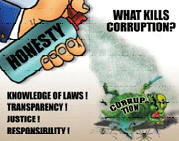 t,
legal
fairness, and government effectiveness.
t,
legal
fairness, and government effectiveness.
Eric
M. Uslaner's research on corruption, inequality, trus t,
legal
fairness, and government effectiveness.
t,
legal
fairness, and government effectiveness.
 Corruption, Inequality, and Trust: The Bulging Pocket Makes the Easy Life
(Published
by Cambridge University Press--Chapters of full manuscript below!)
Paperback published in 2010.
Corruption, Inequality, and Trust: The Bulging Pocket Makes the Easy Life
(Published
by Cambridge University Press--Chapters of full manuscript below!)
Paperback published in 2010.
Chinese translation forthcoming, Chinese Social Sciences Press, 2011; Japanese
edition published in 2012 by Nippon Hyoron Sha publishers; translation by Professor Yoji Inaba of Nihon University (Tokyo) .
Order the book on either link above!
They tell you that the best in life is mental--
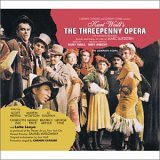 Just
to starve yourself and do a lot of reading
Just
to starve yourself and do a lot of reading
Up in some garret where the rats are breeding.
Should you survive it’s purely
accidental....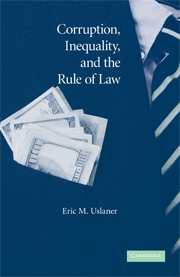
Now once I used to think it would be worthy
To be a brave and sacrificing person.
I soon found out it wasn’t reimbursin’
Decided to continue being earthy.....
Where’s the percentage? asks Mack the Knife.
The bulging pocket makes the easy life.
From "The Ballad of the Easy Life," Berthold Brecht and Kurt Weill, The Threepenny Opera
 Japanese edition cover
Chinese translation forthcoming
Japanese edition cover
Chinese translation forthcoming
Read a non-technical summary of my argument, "Corruption, Inequality, and Trust," in The Handbook on Social Capital, edited by Gert Tinggaard Svendsen and Gunnar Lind Haase Svendsen, London: Edward Elgar
My focus in this book is on corruption and governance. Why is corruption so persistent? How can we overcome corruption?
See the summary of my work and the first paper at TooMuchOnline, also reprinted (with permission) below.
Download the book prospectus (in Word format) and the first paper, "The Bulging Pocket and the Rule of Law" here (in PDF format) as well as a PowerPoint presentation prepared for keynote addresses to the GOPAC (Global Organization of Parliamentarians Against Corruption) meeting in Dhaka, Bangladesh, July 11, 2007.
See also my non-technical summary, “Corruption, Inequality, and Trust,” in Gert Tinggaard Svendsen and Gunnar Lind Haase Svendsen, eds., Handbook on Social Capital (London: Edward Elgar, 2008, forthcoming).
Daniel Jordan Smith of Brown University has reviewed the book for Perspectives on Political Science. Here is his review:
Corruption, Inequality, and the Rule of Law: The Bulging Pocket Makes the Easy Life. By Eric M Uslaner. New York: Cambridge University Press, 2008. 345p. $29.99.
Eric Uslaner’s ambitious book argues that—across a wide range of countries and contexts—the fundamental underlying engine and explanation for corruption is inequality. Mustering an array sources, including survey data, comparative literatures, and personal anecdotes, Uslaner makes a compelling case that the faith often placed in relatively simplistic institutional changes as a means to combat corruption is misguided. Such approaches ignore the deeply embedded economic and social underpinnings of corruption, which he argues are tied less to political institutions (narrowly conceived) and more to systematic inequality and the economic and cultural processes that support it.
Uslaner’s analysis of the relationship between inequality and corruption depends on a crucial indirect mechanism that links inequality and corruption: namely, trust. He shows that low levels of “generalized” or “out-group” trust and high levels of “particularized” or “in-group” trust characterize societies with great inequality, both of which facilitate corruption. The basic argument is that in settings of significant inequality people have little reason to trust out-group others (including—indeed perhaps especially—individuals who control the government), leading to a situation where the state is seen as something that can be (even should be) “grabbed” for one’s in-group.
Using data from multiple national surveys, Uslaner makes the point repeatedly and convincingly that ordinary citizens perceive a connection between inequality and corruption, and that these perceptions matter. The data further suggest that it is large-scale or grand corruption that people find aggrieving, not small-scale corruption. Ordinary folk become habituated to the daily workings of petty corruption, and are relatively unbothered by it. But they do not become inured to grand corruption and perceive it as directly tied to inequality, a finding that appears robust across a range of data sets and country settings.
Uslaner contends that there is an “inequality trap”—a vicious cycle that exists in contexts of high levels of inequality, low levels of generalized trust, and grand corruption. Inequality breeds corruption (and low levels of trust), which gives rise to more inequality. The book portrays both inequality and corruption as “sticky” problems, not easily amenable to quick fixes and simple policy changes. Combating corruption, Uslaner suggests, requires taking on the much larger problem of social inequality.
As a scholar who works on Africa (and in Nigeria in particular), I was pleased to read an account of corruption that looks beyond some of the narrow cultural explanations for corruption in the developing world (especially in Africa) that would have one believe that corruption is a “cultural” problem, peculiar to the Global South. Uslaner begins with an anecdote from his hometown of Paterson, New Jersey, and makes it clear that the connections between inequality, trust, and corruption transcend cultural (as well as national) boundaries. Despite the vast differences between my own discipline’s more ethnographic and particularistic orientation and Uslaner’s more quantitative and sweepingly comparative approach (to an anthropologist like me, the idea that one might expect a single framework to explain cases as dissimilar as Nigeria, Romania, and Singapore appears exceedingly ambitious), I found many resonances between my ethnographic understanding of corruption in Nigeria and Uslaner’s comparative account of corruption everywhere.
A number of themes in the book provoked critical reflections on my experiences with corruption in Nigeria that I elaborate on below as a way to interrogate further the analytical contributions of this fine book. These themes include the relationship between corruption and morality, the connections between petty and grand corruption, the distinction between generalized and particularized trust, and issues related to the origin of corruption and the direction of the causal arrows between corruption and inequality.
I found myself a bit skeptical about Uslaner’s position with regard to the significance of morality for understanding and explaining corruption. According to survey data, average folk do not find petty corruption morally problematic, but they do find high-level corruption morally unacceptable—primarily, Uslaner argues, because it is perceived as causing or exacerbating inequality. Petty corruption is an adaptive response to inequality and thus is experienced as morally acceptable; grand corruption is a cause of inequality and thus is deemed morally unacceptable, Uslaner suggests. While this resonates broadly with my experience in Nigeria and elsewhere, I believe the connections between corruption and morality are frequently more nuanced and complex. For example, many forms of petty corruption are not simply tolerated, as Uslaner suggests, but can run the gamut from ethically imperative (for example, a person who uses his social connections to pull strings in order to get a family member a job they might not otherwise have access to) to ethically despicable (a police officer who demands a bribe to investigate a crime). The moral dimensions of petty corruption, rather than being largely absent, are often highly salient. Further, context and position frequently shape popular perceptions of grand corruption, at least in Nigeria. For example, a corrupt federal minister can be seen as a hero in his state of origin and a villain in another region (all of which supports Uslaner’s argument about in-group versus out-group trust, but complicates any notion that one can easily paint petty corruption as morally neutral and grand corruption as morally wrong).
Related to the issue of morality is the question of the connections between petty and grand corruption. While I largely agree with Uslaner’s argument (supported by the data he provides) that it is grand corruption that creates the context for petty corruption rather than vice-versa, I am not convinced that the prevalence of petty corruption is unrelated to the social reproduction of grand corruption. Uslaner gives great weight (in my view, appropriately) to the significance of people’s perceptions about the links between inequality and corruption. In the same vein, I take seriously the perception in Nigeria among ordinary people that they are in some ways complicit in the perpetuation of grand corruption. While I believe Uslaner is correct in seeing petty corruption as a means of surviving in the context of the inequality trap, it seems to me that the possibilities for political change that would address corruption by redressing inequality are inhibited by the pervasive practices of petty corruption that lead people to conclude there is no other way to respond to grand corruption and tremendous inequality. The context for the most socially injurious forms of corruption is social inequality, and challenges to inequality must ultimately be political. To me, this means that for change to occur ordinary citizens must create political pressure to combat inequality; such collective action is arguably inhibited by pervasive petty corruption.
On another matter, Uslaner argues that social inequality undermines generalized trust and makes particularized trust more powerful, thus facilitating corruption. I wonder if there isn’t a bigger story to tell. Might not a larger set of sociological forces be at play, related to the transition from more face-to-face forms of governance and sociality to more anonymous arrangements? In other words, the very notion of generalized trust could be argued to be a fairly new (and, frankly, quite peculiar) phenomenon in human societies that needs to be interrogated and understood rather than taken for granted.
Perhaps the weakest aspect of this excellent book, from my point of view, is the lack of an historical perspective. Uslaner admits that we know much more about why corruption persists than why it starts, but I think more attention to historical contexts (which, of course would run against the comparative grain of an explanation designed to account for almost all cases everywhere) would go a long way to addressing this question. While I think Uslaner is correct that the nexus between inequality, trust, and corruption has become a vicious circle in which causality is not simply linear, the lack of attention to history preempts any possibility for an account that could tell us more about origins (and therefore, perhaps, about pathways forward).
In some ways this is a curious book for a political scientist to write about corruption, because it argues against the explanation that I might imagine (perhaps naively, as a non-political scientist) would be most conventional in political science: namely, the centrality of politics and institutions. Ultimately, I found Uslaner’s argument about the significance of inequality to be compelling. He rejects the “broken window” model, in which grand corruption is tackled by taking on petty crime. His evidence that it is more (and better) government, not less, that is the best policy prescription to combat corruption is an important finding in an era of neoliberal policies. Given Uslaner’s persuasive argument that it is inequality that is at the root of corruption and at the center of ordinary people’s discontents, I couldn’t help wondering what he thinks of societies (like the United States) that have maintained tremendous inequality but reconfigured the mechanisms for reproducing these disparities such that they are no longer branded as corrupt.
Daniel Jordan Smith, Brown University
This project offers both an innovative (and controversial) theory of
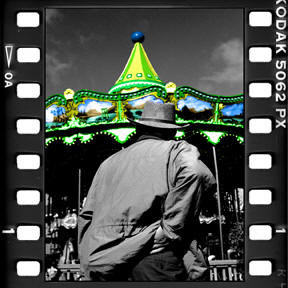

corruption, inequality,
trust and mistrust, 
legal fairness, and government effectiveness-- as well as employing novel measures of legal fairness and government effectiveness.
New!!! Download Chapters 1, 2, 3, 4, 5, 6, 7, 8, 9, the references, the tables for these chapters, and the appendix tables.
Chapter summaries:
Chapter 1: Introduces the study with a story of my first experience with corruption, examines the problem of defining "corruption," and the controversies surrounding its measurement. Summary of the chapters to come.
Chapter 2: Theoretical framework of the "inequality trap," the link between inequality, trust, and corruption and why corruption is so difficult to eradicate. I also show that corruption, far more than effective government, leads to public policies that produce better quality of life, stronger market performance, and less inequality.
Chapter 3: Aggregate cross-national tests of the inequality trap thesis and analysis of cross-national surveys (the Gallup Millennium Survey of 2004 and the 2004 Global Corruption Barometer).
Chapter 4: The persistence of corruption and low trust in transition countries and the rise of inequality give rise to the inequality trap in these nations. In this chapter I present aggregate portraits of these trends as well as aggregate analyses of the determinants of corruption, inequality change, state failure, service deterioration, sales on credit, the sources of gift payments, and the persistence of voting for the Communist party in these states--as well as individual-level analyses of businesspeoples' decisions to make sales on credit. The results provide strong support for the inequality trap argument.
Chapter 5: Romania is an excellent case study for the inequality trap among transition countries. It has historically high levels of corruption and it also has strong ethnic conflict, leading to low generalized trust. Inequality has also been rising sharply since transition. Using a 2003 survey, I examine the linkages among perceptions of inequality, trust, and corruption and find strong support for my argument--and especially the notion that grand corruption leads to social strains and to perceptions of rising inequality, low trust in other people and in government, and in support for political and market reforms, while petty corruption (except for the legal system) does not lead to social strains.
Chapter 6: Estonia is the transition country that seems to have reduced corruption the most and Slovakia is the transition country that has had the smallest increase in inequality. Using surveys of the public, entrepreneurs, and officials in these two countries as well as in Romania, I show that in all three countries people do worry about the linkage between inequality and corruption, but that elites are less likely to make this connection than are ordinary people (especially in Estonia) and that where inequality has risen less (in Slovakia), both the public and elites are less likely to make the connection than where it has risen more sharply.
Chapter 7: Africa is a perhaps the best test case for the inequality trap argument, since it is marked by high inequality, low trust, and high levels of corruption. Using Afrobarometer data for 14 African countries and specifically country-level surveys in Mali and Nigeria, I find strong support for linkages between inequality and corruption as people perceive them. In Botswana, where government has become more honest, the linkages are not significant. Singapore and Hong Kong are perhaps the most clear-cut counterexamples to the inequality trap. I examine why this is so and suggest that the social conditions that gave rise to strong efforts to combat malfeasance in public life are not easily transferred to other countries' experiences.
Chapter 8: The Nordic countries constitute another key test. They rank high on equality and trust and low on corruption. Analysis of survey data from Wave 3 of the World Values Survey show that Nordic perceptions on corruption rest on trust and confidence in key institutions, especially the police and the civil service. Attitudes about inequality and poverty are not significant, as expected. The United States is a relatively low corruption country but with mid-level rankings on trust and inequality (trust has been falling, inequality rising). Survey data do not provide much support for an inequality trap in the United States, either for people in general (the 1987 General Social Survey) or for believing whether most politicians are crooked (the 2004 American National Election Studies), although there is a greater effect for leaders than ordinary citizens. Corruption varies widely across the American states. A cross-state analysis of reporters' perceptions of corruption in state legislatures leads to strong support for the inequality trap argument, however. Both overall inequality and the ratio of African-Americans to whites in poverty are strong predictors of corruption perceptions (as is generalized trust). Reporters' perceptions of corruption are related to the vote for Progressive Presidential candidate Robert LaFollette in 1924, and both corruption perceptions in 1999 and the LaFollette vote are strongly predicted by the white collar share in 1920 as well as the share of a state's population born to Scandinavian parents in 1880. This strongly supports my argument that corruption is sticky over time.
Chapter 9 : Conclusion. How can we eliminate corruption? Following Wilson and Kelling's argument on "broken windows," starting at the ground level may be the right course. I first show that corruption is strongly related to property crimes (but NOT crimes of violence, especially pickpocketing, using aggregate data from the International Crime Victimization Surveys. If we curb street crime, is this a path to curbing corruption? A simultaneous equation model shows that corruption leads to more crime (leaders set a bad example), but reducing crime will have a minor effect on corruption. So we must look elsewhere. This brings us back to programs that reduce inequality and I speculate on how political leaders in New York City may have created the conditions for their own demise by providing free public university education for a large number of students.
Comments
appreciated.
See the PowerPoint presentation I have made for presentation at various conferences, "Trust and Corruption in Transition," in which I present a synopsis of the full argument (applying to both transition countries and all countries). As cited in The New Yorker and by Paul Krugman in the Rolling Stone!
Lecturing at the National Defense College, Dhaka, Bangladesh; the Millennium University/ Khan Foundation, Dhaka, Bangladesh (both July 9, 2007), and at the Southwest University of Political Science and Law, Chongqing, China (June, 2007).
The book includes extensive aggregate cross-national analyses as well as survey data not widely available: surveys conducted by my Romanian colleague Gabriel Badescu, Transparency International's Global Corruption Barometer for 2004, and surveys of the mass public, government officials, and business people in Estonia conducted by the Estonian government.
The focus will be cross-national with particular attention to the transition countries, where corruption is and has been a pressing problem.
Corruption is generally
considered to be a curse. It flouts rules of fairness and gives some people
advantages that others don’t have. Corruption transfers resources from the mass
public to the elites–and generally from the poor to the rich. It acts as an
extra tax on citizens, leaving less money for public expenditures. Corrupt
governments have less money to spend on th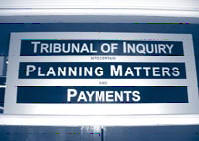 eir
own projects, pushing down the salaries of public employees. In turn, these
lower-level staffers will be more likely to extort funds from the public purse.
Government employees in corrupt societies will thus spend more time lining their
own pockets than serving the public. Corruption thus leads to lower levels of
economic growth and to ineffective government.
eir
own projects, pushing down the salaries of public employees. In turn, these
lower-level staffers will be more likely to extort funds from the public purse.
Government employees in corrupt societies will thus spend more time lining their
own pockets than serving the public. Corruption thus leads to lower levels of
economic growth and to ineffective government.
Economic inequality
provides a fertile breeding ground for corruption–and, in turn, it leads to
further inequalities. Most of the models o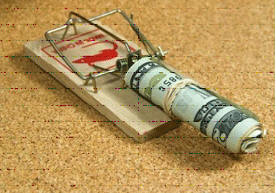 f corruption focus on the
institutional determinants of government dishonesty. However, such accounts are
problematic. Corruption is remarkably sticky over time. There is a very powerful
correlation between cross-national measures corruption in 1980 and in 2004. In
contrast, measures of democracy such as the Freedom House scores are not so
strongly correlated over time–and changes in corruption are unrelated to changes
in institutional design. On the other hand, inequality and trust–like
corruption–are also sticky over time.
f corruption focus on the
institutional determinants of government dishonesty. However, such accounts are
problematic. Corruption is remarkably sticky over time. There is a very powerful
correlation between cross-national measures corruption in 1980 and in 2004. In
contrast, measures of democracy such as the Freedom House scores are not so
strongly correlated over time–and changes in corruption are unrelated to changes
in institutional design. On the other hand, inequality and trust–like
corruption–are also sticky over time.
The connection between inequality and the quality of government is not necessarily so simple: As the former Communist nations of Central and Eastern Europe show, you can have plenty of corruption without economic inequality. The aggregate relationships between inequality and corruption are not strong. The path from inequality to corruption may be indirect–through generalized trust–but the connection is key to understanding why some societies are more corrupt than others.
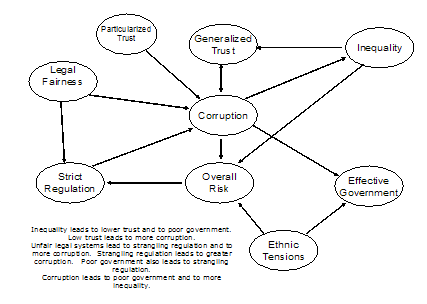 In the first paper,
"The
Bulging Pocket and the Rule of Law: Corruption, Inequality, and Trust," (first
delivered at the at the 2005 meetings of the Society for the Advancement of
Socio-Economics, Budapest, Hungary and revised for the Conference on the Quality
of Government, Goteborg University, Sweden, November 2005) I estimate a set of
simultaneous equations cross-nationally and show that there is strong support
for the linkage from high inequality to low generalized trust to high levels of
corruption–and then back to higher levels of inequality, leading to an
"inequality trap." In contrast, there are few institutional determinants
of corruption.
In the first paper,
"The
Bulging Pocket and the Rule of Law: Corruption, Inequality, and Trust," (first
delivered at the at the 2005 meetings of the Society for the Advancement of
Socio-Economics, Budapest, Hungary and revised for the Conference on the Quality
of Government, Goteborg University, Sweden, November 2005) I estimate a set of
simultaneous equations cross-nationally and show that there is strong support
for the linkage from high inequality to low generalized trust to high levels of
corruption–and then back to higher levels of inequality, leading to an
"inequality trap." In contrast, there are few institutional determinants
of corruption.
I also propose a new
measure of government effectiveness, based upon survey responses by
business executives to the World Economic Forum's 2004 Executive Opinion Survey
based upon responses to questions on the independence and efficiency of the
judiciary, the efficiency of the legislature, the wastefulness of government
spending, favoritism in gove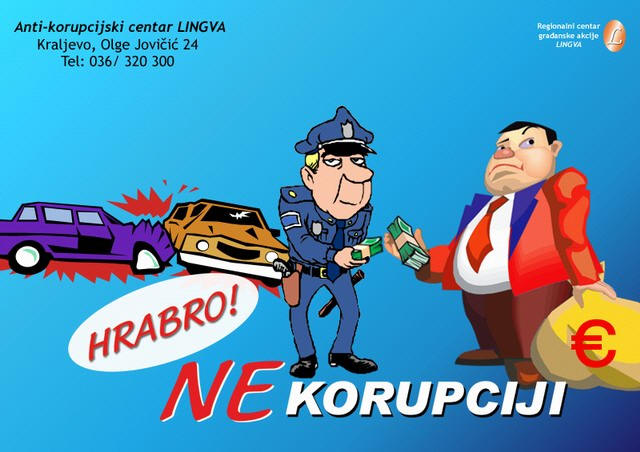 rnment decision-making, and the transparency of
government decision-making. This new measure is formulated independently
of corruption, but is clearly affected by it. As with corruption, the
foundations of effective government are more closely connected to social strains
within the society (especially trust) rather than structural features of the
polity.
rnment decision-making, and the transparency of
government decision-making. This new measure is formulated independently
of corruption, but is clearly affected by it. As with corruption, the
foundations of effective government are more closely connected to social strains
within the society (especially trust) rather than structural features of the
polity.
There is one key
institutional factor that matters mightily for both corruption and the
strangling regulation that leads to corruption: the fairness of the legal
system. Here I use a measure of legal fairness that is also formulated
independently of corruption--the legal fairness index of the Executive
Intelligence Unit.
In later chapters, I will discuss the consequences of corruption: closed markets, greater inequality, greater levels of tax evasion. Societies with high levels of corruption also have higher rates of property crime, but there is no connection to crimes of violence against women. Higher rates of property crime point to the common roots of corruption and crime: inequality and low trust. In the paper, "The Bulging Pocket and the Rule of Law," I discuss some preliminary results, notably the strong relationship between levels of corruption and pickpocketing (estimated from the International Crime Victimization Surveys).
I also show more direct connections between a more nuanced measure of inequality (the ratio of black to white/poverty ratio in the American states, together with trust, and reporters’ perceptions of corruption in the American states. I also show indirectly that corruption has a long historical legacy in the United States (see my paper "The Civil State" below).
The Connection Between Trust and Corruption
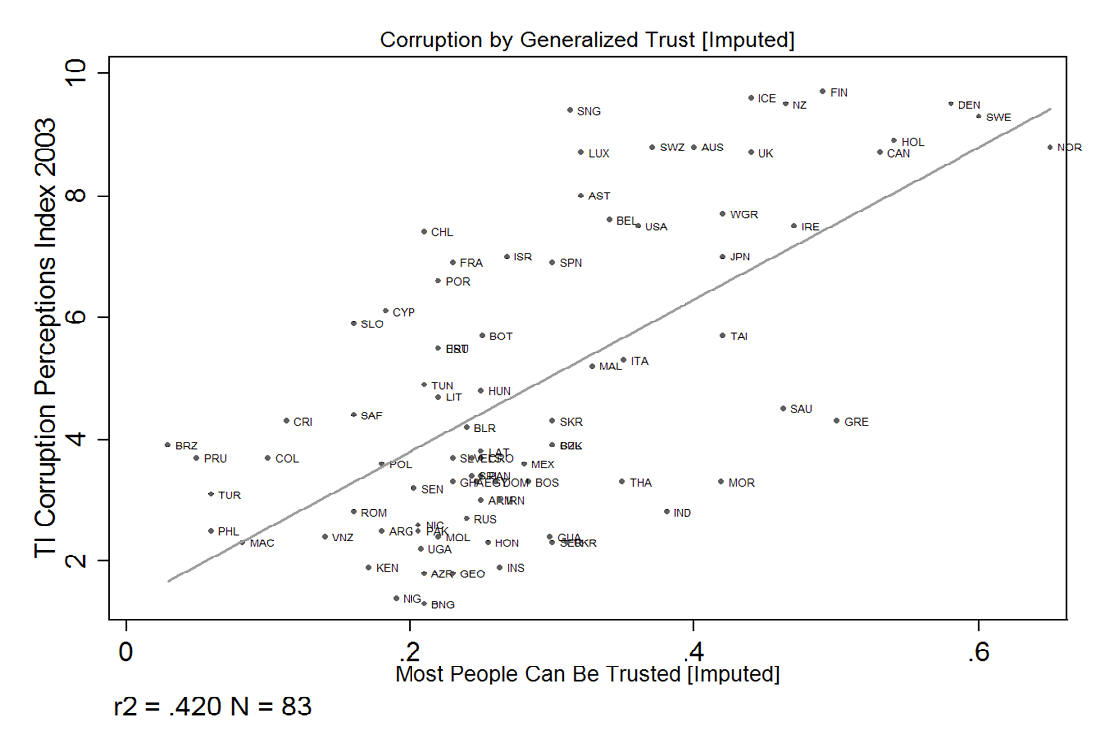
The Connection Between Legal Fairness and Corruption
The Basic Model from the paper, "The Bulging Pocket and the Rule of Law"

Corruption at the top--by politicians and businesspeople--stems from low trust and high inequality, as well as an unfair legal system. Yet corruption at the top also reflects a lack of respect for the rule of law from below. There is a strong relationship between pickpocketing (as seen by the public in the International Crime Victimization Survey) and corruption. There are similar (though weaker) relationships with other economic crimes such as car theft and fraud--but this does not indicate a more general linkage with crime. There is no statistical relationship between corruption and violent crimes (such as assault and sexual assault). The graph on the left shows the relationship between corruption and pickpocketing. While the Czech Republic ranks in the top third of honesty in Transparency International's 2005 Corruption Perceptions Index, corruption is a pressing political issue in the country (see below). And the Prague Metro is filled with signs such as the one on the right (both in English and in Czech) warning about street-level corruption.
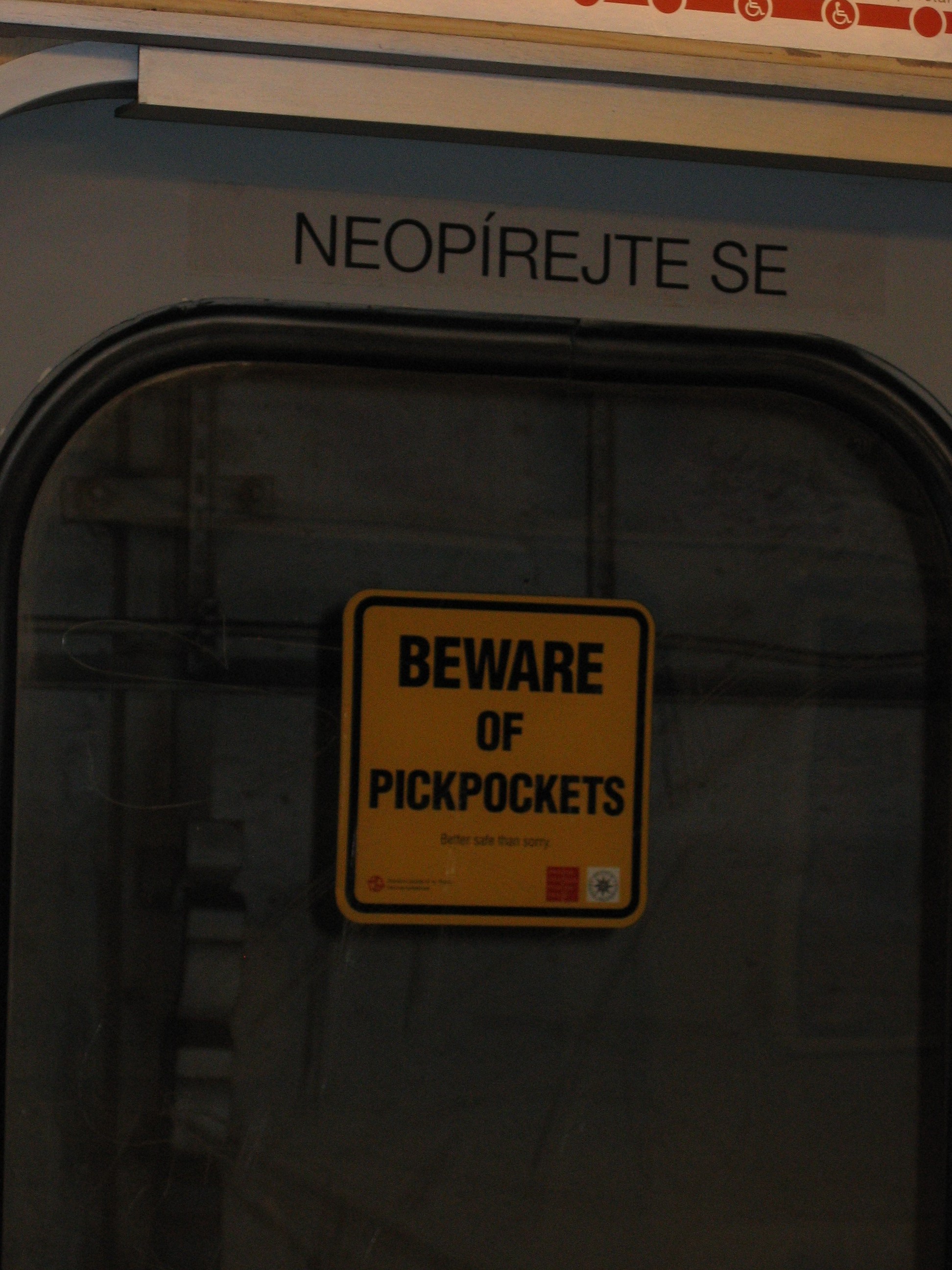
TooMuch Online (November 21, 2005) summarized my work (reprinted by permission):
Honesty demands a level of trust, argues a leading University of Maryland political scientist, that distinctly unequal societies simply cannot deliver.
November 21, 2005
A few recent stories from our nation's front pages:
• The Justice Department has charged a U.S. official in Iraq with rigging bids on contracts worth millions of dollars — in exchange for a $546,000 payoff.
• News reports reveal that Jack Abramoff, the right-wing wheeler-dealer with connections deep inside the White House, demanded $9 million from a West African nation to arrange a meeting with President Bush.
• A federal grand jury has indicted media baron Conrad Black for looting $51.8 million from the company that owns the Chicago Sun-Times.
We live, our daily headlines make clear, in corrupt times. But epochs of corruption, history makes clear, tend to come and go. Some societies, at some times, exhibit far more corruption than others.
Why should that be so? Last week, at an international conference at Sweden's Göteborg University, University of Maryland political scientist Eric Uslaner shared an answer.
Some societies turn out to be more corrupt than others, Uslaner explained in a provocative introduction to his research, because some societies distribute wealth and income far more unequally than others.
We desperately need to understand, Uslaner believes, why corruption flourishes in some societies and not others — for a variety of reasons.
Corruption, Uslaner notes, “acts as an extra tax on citizens, leaving less money for public expenditures.” With less in the way of resources, corrupt governments have less to pay their public employees, who, in turn, become more likely to spend time “lining their own pockets than serving the public.”
What happens to tax dollars in corrupt societies? Top officials routinely fritter them away in big public works projects “where they can channel contracts to their cronies.” The more these contracts “empty the treasury,” the fewer tax dollars available “for investments in programs that benefit those at the bottom of the economic ladder.”
Corruption, in effect, amounts to an attack on the everyday quality of life of everyday people.
How do we fight corruption? The knee-jerk answer — throw the crooks in jail — seldom works. New crooks, Uslaner notes, almost always arise to take the place of the old.
Peru, over the past decade. has offered an stark case in point. Thanks to a series of media exposés, we now know that Peru's secret police chief “bribed judges, politicians, and especially the owners of television stations” throughout the 1990s. These exposés eventually led to the indictment of the police chief’s top patron, Peruvian President Alberto Fujimori.
But these revelations did not lead to cleaner government. Peru’s ranking on Transparency International’s corruption index actually deteriorated between 1998 — before Fujimori fell — and 2005.
“The exposure of corrupt media and the ensuing media campaign that felled the government failed to have lasting effects,” notes Uslaner. “The videos of the chief of secret police negotiating bribe prices seem to be no more lasting than episodes of CSI.”
New crooks will always arise to replace old crooks, some political scientists contend, because the roots of corruption sit in poorly functioning and inefficient government institutions. Fix those institutions, this perspective maintains, and corruption will wither and die.
Uslaner disagrees. Institutions, he argues, “reflect the underlying culture of a society.” Corrupt institutions reflect cultures where “generalized trust” between people has faded away. And what nurtures this mistrust? That distinct dishonor belongs to inequality.
“The roots of corruption,” Uslaner writes, “lie in the unequal distribution of resources in a society.”
In unequal societies, as political scientists Edward Glaeser, Jose Scheinkman, and Andrei Schleifer have noted, those with the deepest pockets have the wherewithal “to subvert the political, regulatory, and legal institutions of society for their own benefit.” Ordinary citizens, adds Uslaner, come “to see the system as stacked against them.”
In this environment, people start to feel that connections matter more than honest hard work. And that leads to “a willingness to do whatever is necessary to make your way in the world,” even cheat on other people. And if you’re willing to cheat on others, they must be willing to cheat on you.
The inevitable byproduct of this mutual mistrust: a lack of empathy for everyone beyond your own narrow circle. You can’t care about people you can’t trust.
Trusting societies, by contrast, nurture a different dynamic.
“Faith in others leads to empathy for those who do not fare well, and ultimately to a redistribution of resources from the well-off the poor,” notes Uslaner. “If we believe that we have a shared fate with others, and especially people who are different from ourselves, then gross inequalities in wealth and status will seem to violate norms of fairness.”
In these more trusting societies, public policies that limit inequalities will find widespread support.
Uslaner’s new research suggests “a model where inequality, mistrust, and corruption are mutually reinforcing.” To make his case, he taps a wide range of data sets, everything from the Freedom House index of civil and political rights to cross-national opinion polling of average citizens and business executives.
Equality, all this data crunching ends up showing, makes for “the strongest predictor of trust.” Levels of generalized trust, Uslaner’s research demonstrates, shrink as inequality rises.
Uslaner’s analysis offers no easy happy ending. Ending corruption, he notes, would be difficult but doable if that task essentially boiled down only to the fixing of corrupt institutions. But the roots of corruption sink far deeper, Uslaner argues, so deep that reformers will never be able to pull these roots out unless they confront, head on, their society’s rich and mighty.
“Changing institutions may not be easy,” Uslaner explains, “but its difficulty pales by comparison with reshaping a society’s culture or its distribution of wealth (and power).”
But this confronting must be done.
“To overcome the pessimism that inequality generates, government must do more than make the trains run on time,” Uslaner sums up. “Everyone should ride in a comfortable cabin, if not in the same class.”
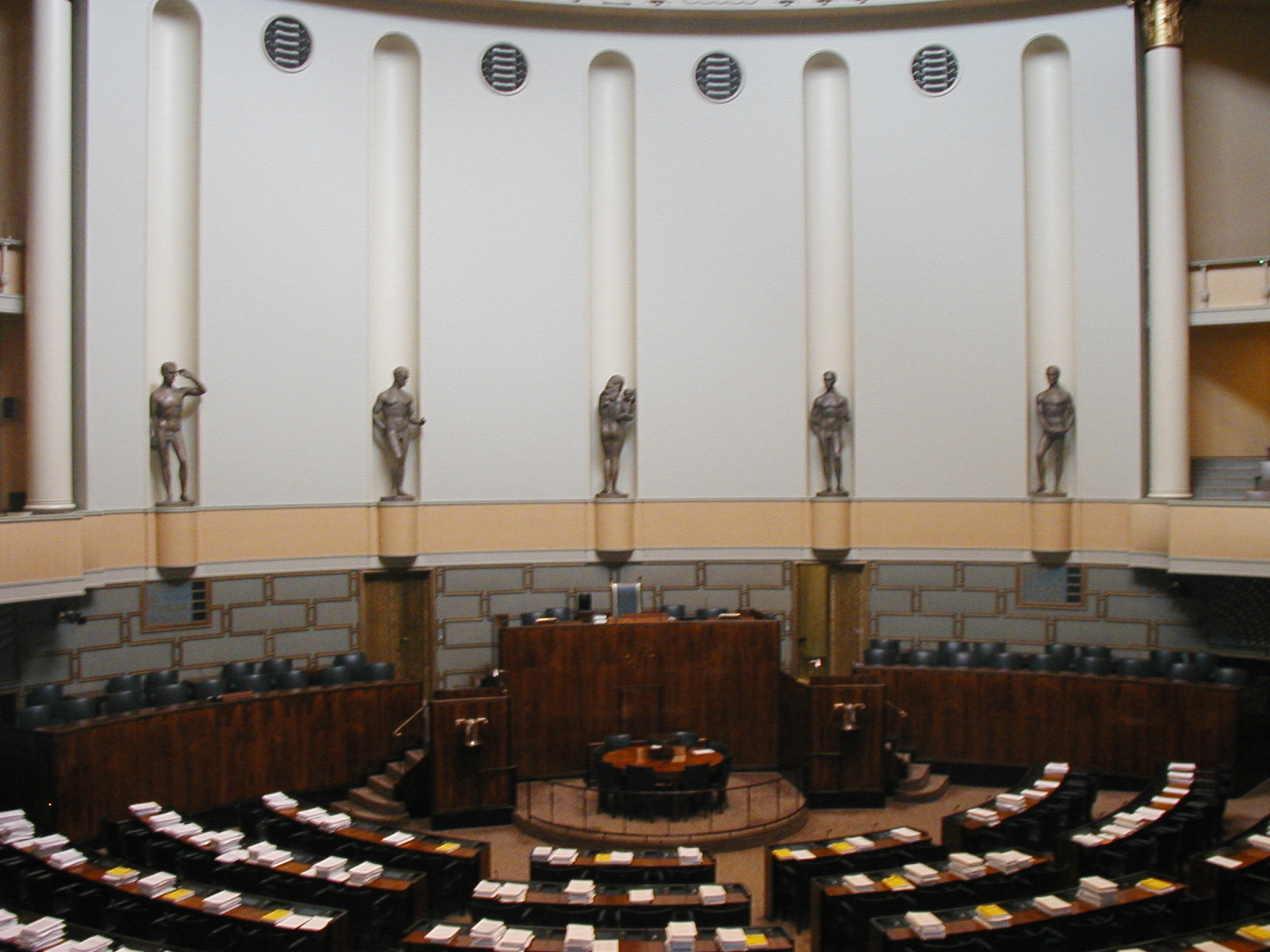
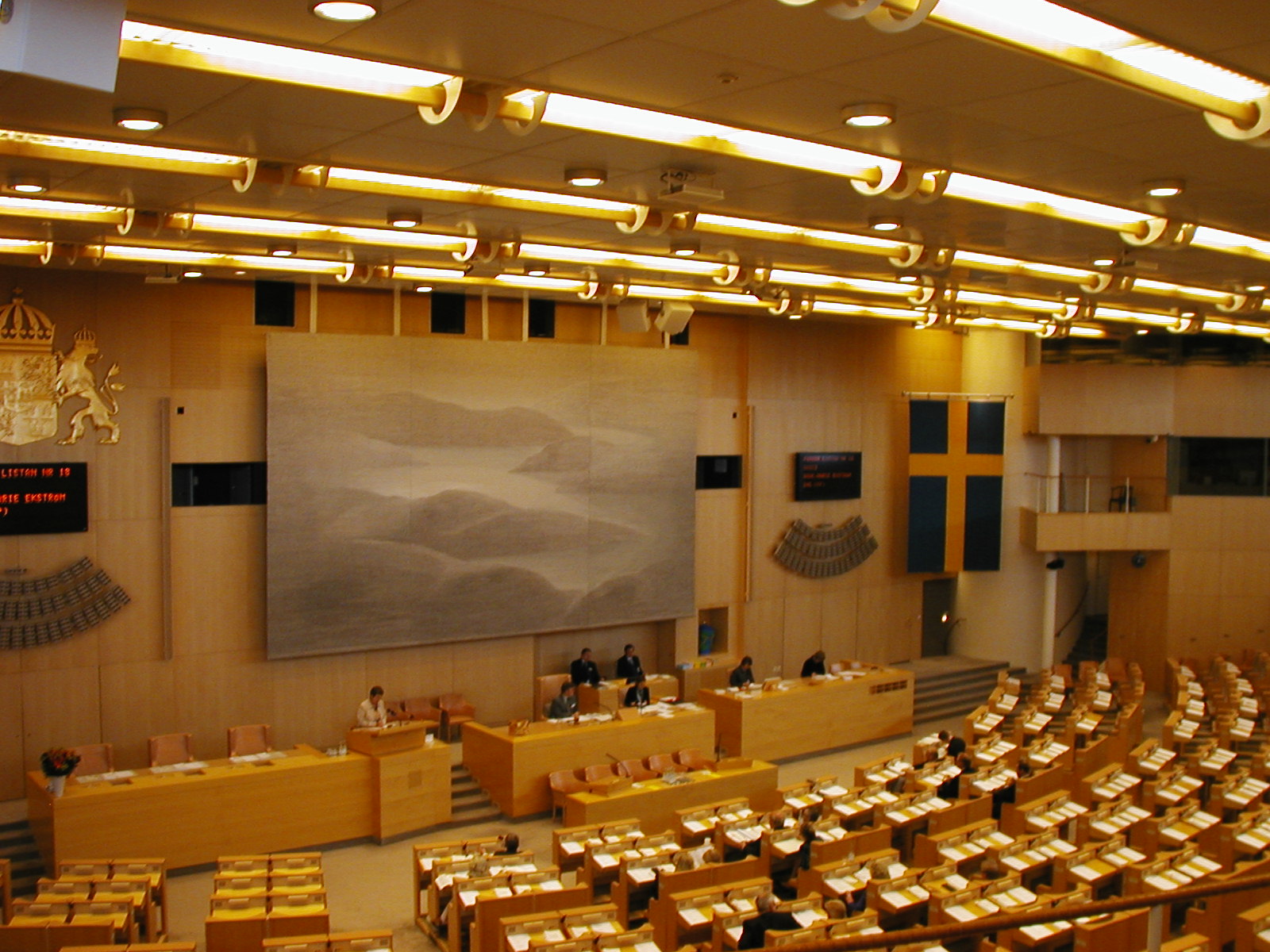
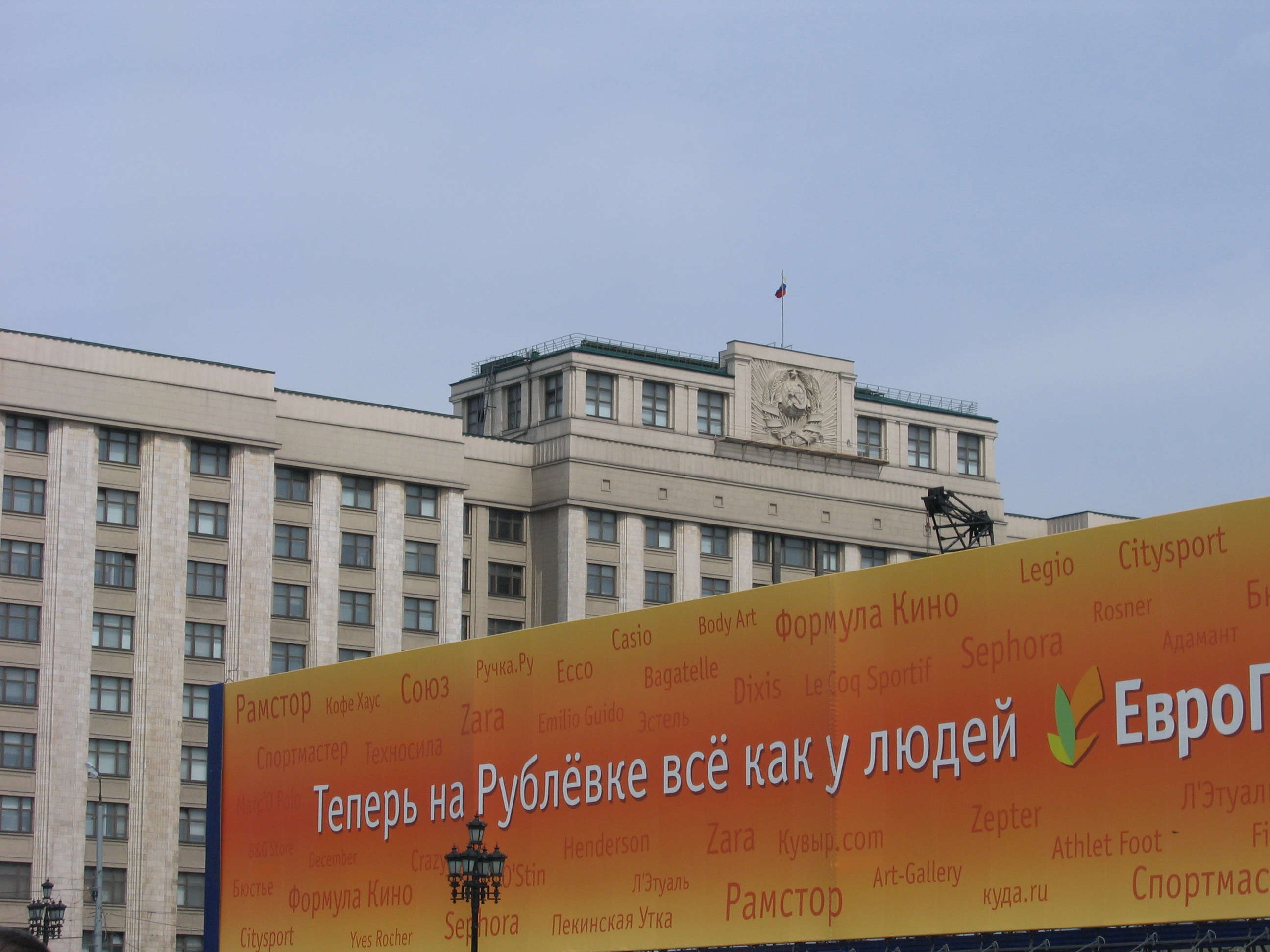
Three legislatures: two in the least corrupt countries in the world, according to Transparency International: Finland, on the left, and Sweden in the center. The third is the Russian Duma, in one of the more corrupt countries.
Also see these other papers that will feature prominently in the book:
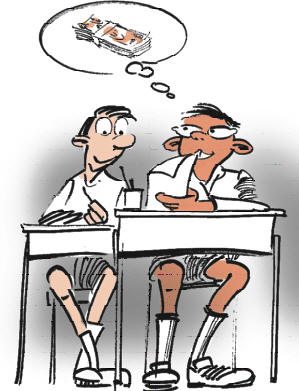 (with Gabriel Badescu): "Honesty, Trust, and Legal Norms in the Transition to
Democracy: Why Bo Rothstein Is Better Able to Explain Sweden than
Romania," for presentation at Collegium Budapest Project on Honesty
and Trust Conf
(with Gabriel Badescu): "Honesty, Trust, and Legal Norms in the Transition to
Democracy: Why Bo Rothstein Is Better Able to Explain Sweden than
Romania," for presentation at Collegium Budapest Project on Honesty
and Trust Conf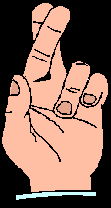 erence, Workshop on Formal and Informal Cooperation,
November 22-23, 2002, Budapest, Hungary and at the Conference on
"Corrupt Transactions Exploring the Analytical Capacity of
Institutional Economics," University of Göttingen, November 15-16
2002; at the G17 Summer School, Belgrade, Serbia, July, 2003; and at
the International Institute in Institutional Analysis of the
University of Tubingen (Germany) at the University of Sofia
(Bulgaria), August 31-September 7, 2003. The paper appears
in Janos Kornai, Susan Rose-Ackerman, and Bo Rothstein, eds.,
Creating Social Trust: Problems of Post-Socialist Transition (New
York: Palgrave, 2004. Download the revised paper in
Word
format. Cartoon on the left from
http://transparencymauritius.intnet.mu/student.htm.
erence, Workshop on Formal and Informal Cooperation,
November 22-23, 2002, Budapest, Hungary and at the Conference on
"Corrupt Transactions Exploring the Analytical Capacity of
Institutional Economics," University of Göttingen, November 15-16
2002; at the G17 Summer School, Belgrade, Serbia, July, 2003; and at
the International Institute in Institutional Analysis of the
University of Tubingen (Germany) at the University of Sofia
(Bulgaria), August 31-September 7, 2003. The paper appears
in Janos Kornai, Susan Rose-Ackerman, and Bo Rothstein, eds.,
Creating Social Trust: Problems of Post-Socialist Transition (New
York: Palgrave, 2004. Download the revised paper in
Word
format. Cartoon on the left from
http://transparencymauritius.intnet.mu/student.htm.
Czech anti-corruption party SNK ED leader Jan Kasl (left) meets a voter on the street off Wenceslas Square in Prague on June 5, 2006. Two volunteers for the party look for other voters who might take their party literature. There were not many takers (as the picture shows). Even in the midst of a major corruption scandal, the ruling Social Democrats barely lost power to the opposition Civic Democrats in the following weekend's election. SNK ED did not receive a single seat in Parliament. Corruption is not easy to eradicate.
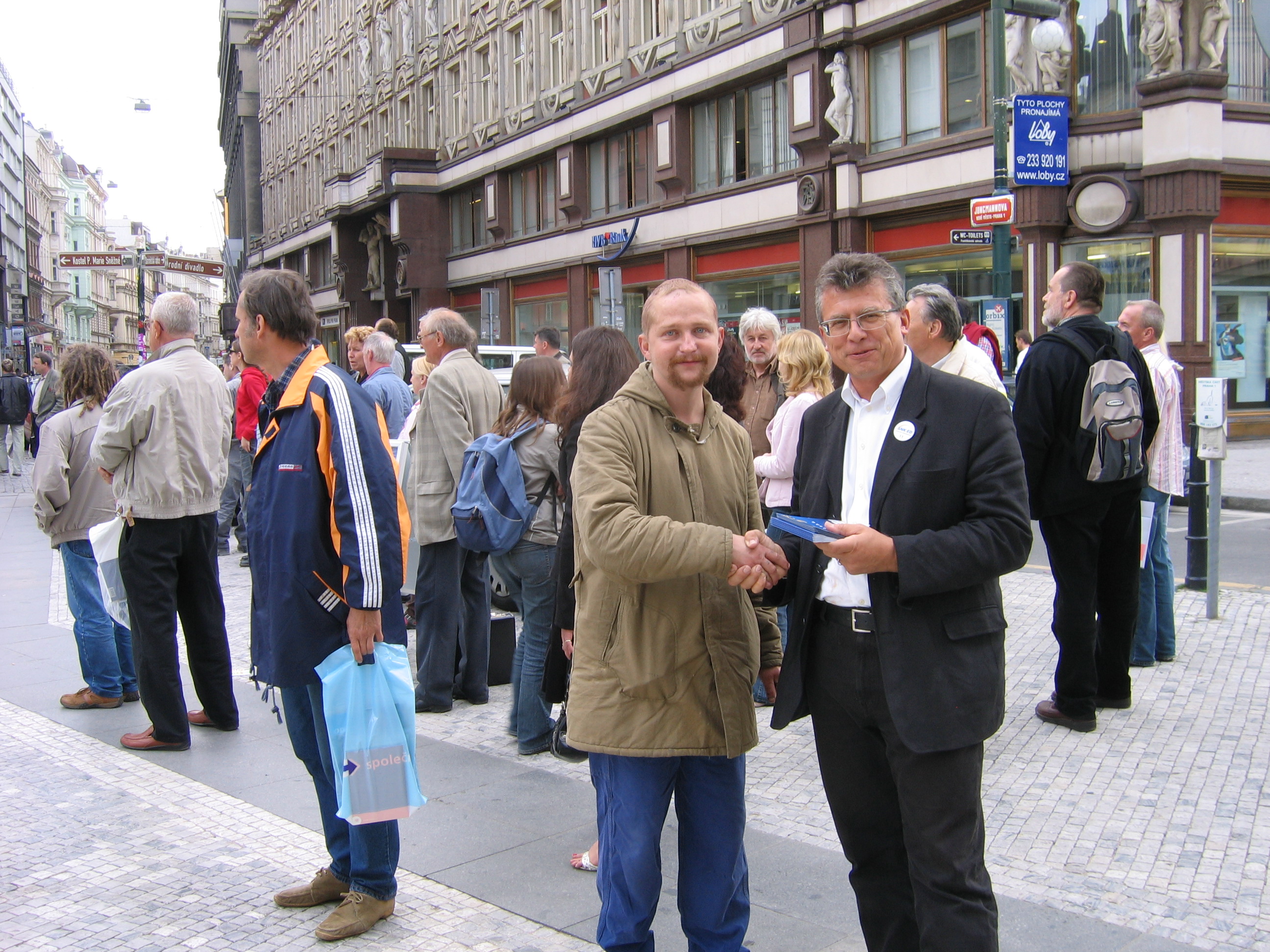
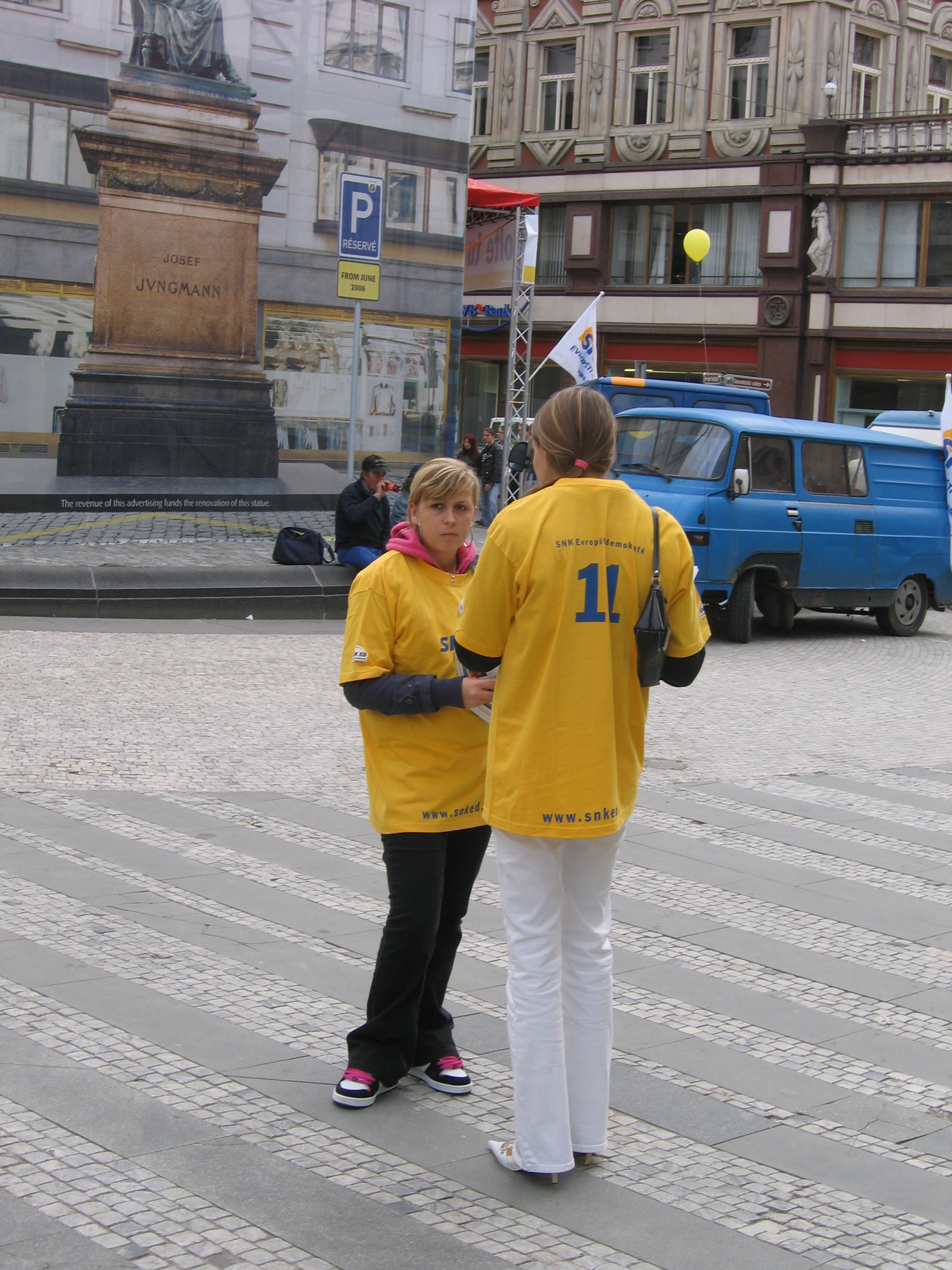
Trust is limited in Belgrade, Serbia (see the wall graffiti on the right), where one form of authoritarian rule was replaced by another.
War can destroy
trust too: a building next to the Serbian Defense Ministry hit by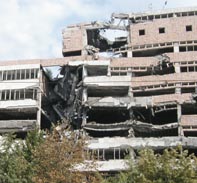 U.S. bombs in the campaign to end ethnic cleansing in Kosovo.
U.S. bombs in the campaign to end ethnic cleansing in Kosovo.
Even more so, calls to ethnic hatred can destroy trust. Above, Serbians gather signatures demanding war crimes charges be dropped against former dictator Slobodan Milosevic.
(with Gabriel Badescu): "Making the
Grade in Transition" where we examine both aggregate linkages between
inequality, corruption, and political institutions in transition
countries and survey evidence from Romania to argue that high level
corruption can lead to lower trust in both people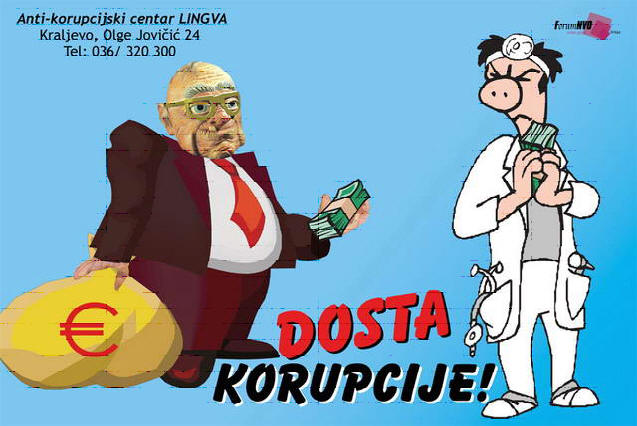 and in government
and to demands for redistribution of wealth. Perceptions of
rising inequality erode trust in both people and in government as
well--but street level corruption has little effect on people's
attitudes toward their political or social system. Download the
PDF file.
and in government
and to demands for redistribution of wealth. Perceptions of
rising inequality erode trust in both people and in government as
well--but street level corruption has little effect on people's
attitudes toward their political or social system. Download the
PDF file.
In "Coping and
Social Capital," I show that the informal economy--using connections
to get around the bureaucracy and in other areas of daily life and
making extra "gift" payments to public officials, police officers,
courts, doctors, and banks--generally do not shape trust or
satisfaction with the market or democracy in Romania. They do
shape views on increasing inequality, but it is higher-level
corruption rather than petty corruption that shapes trust and
satisfaction with
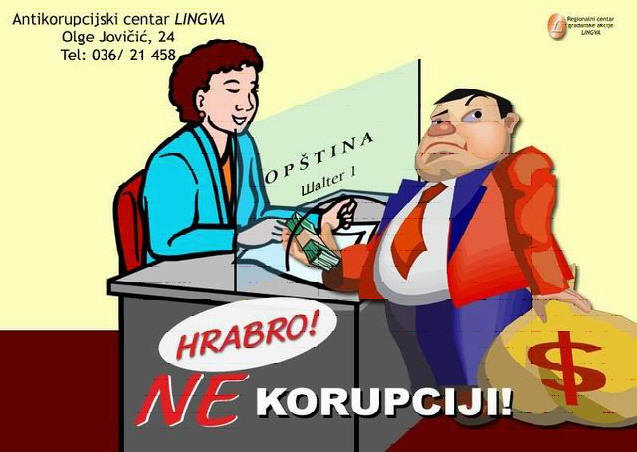 the market and with government performance.
This paper was prepared for the conference, "Unlocking Human
Potential: Linking the Formal and Informal Sectors," Helsinki,
Finland, September 17-18, 2004.
Download the PDF file.
the market and with government performance.
This paper was prepared for the conference, "Unlocking Human
Potential: Linking the Formal and Informal Sectors," Helsinki,
Finland, September 17-18, 2004.
Download the PDF file.
Courageously, no corruption! From the Serbian anti-corruption site: http://www.forumnvo.org.yu/antikorupcija_2/Lokalna%20samouprava.jpg
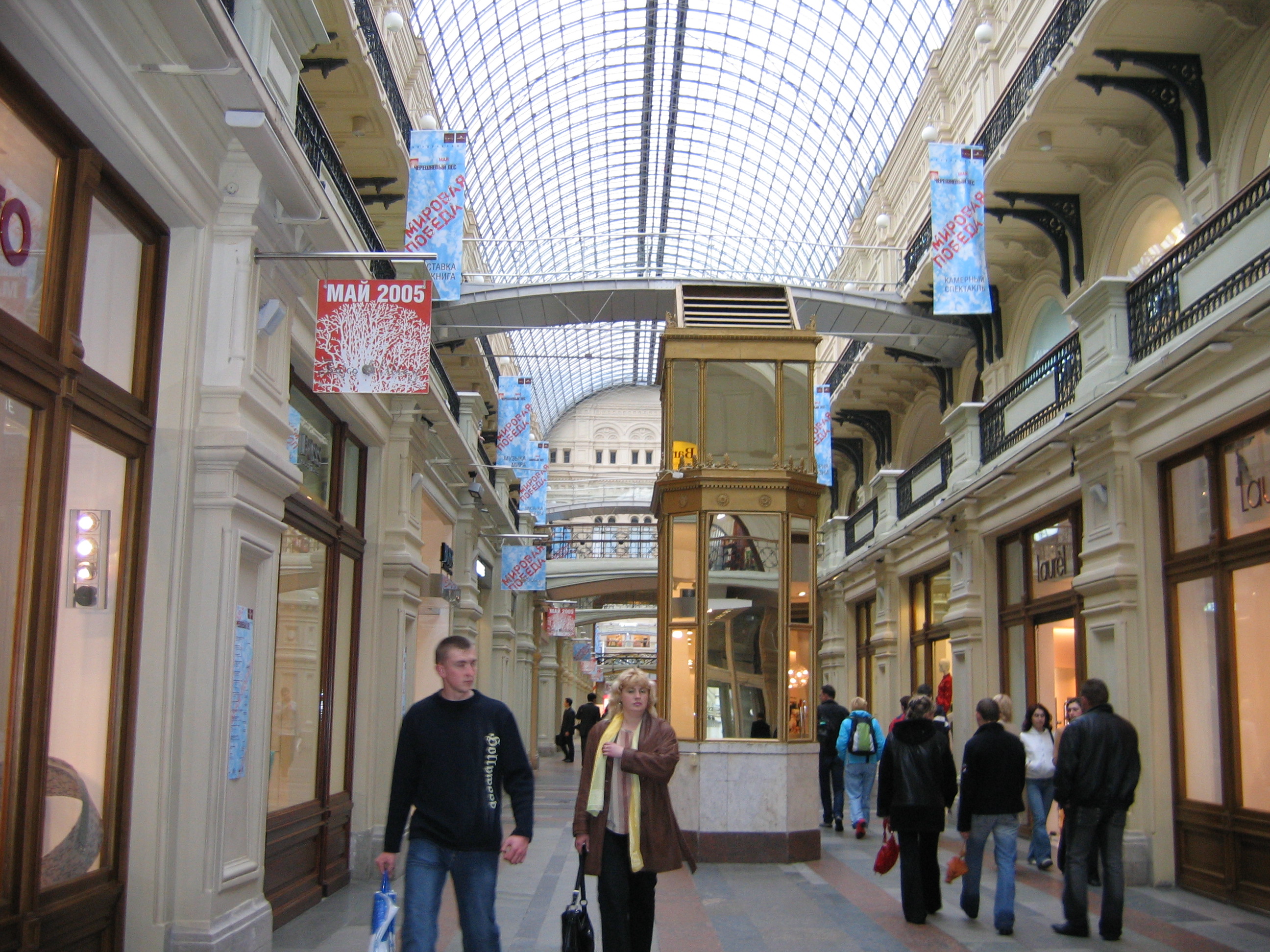
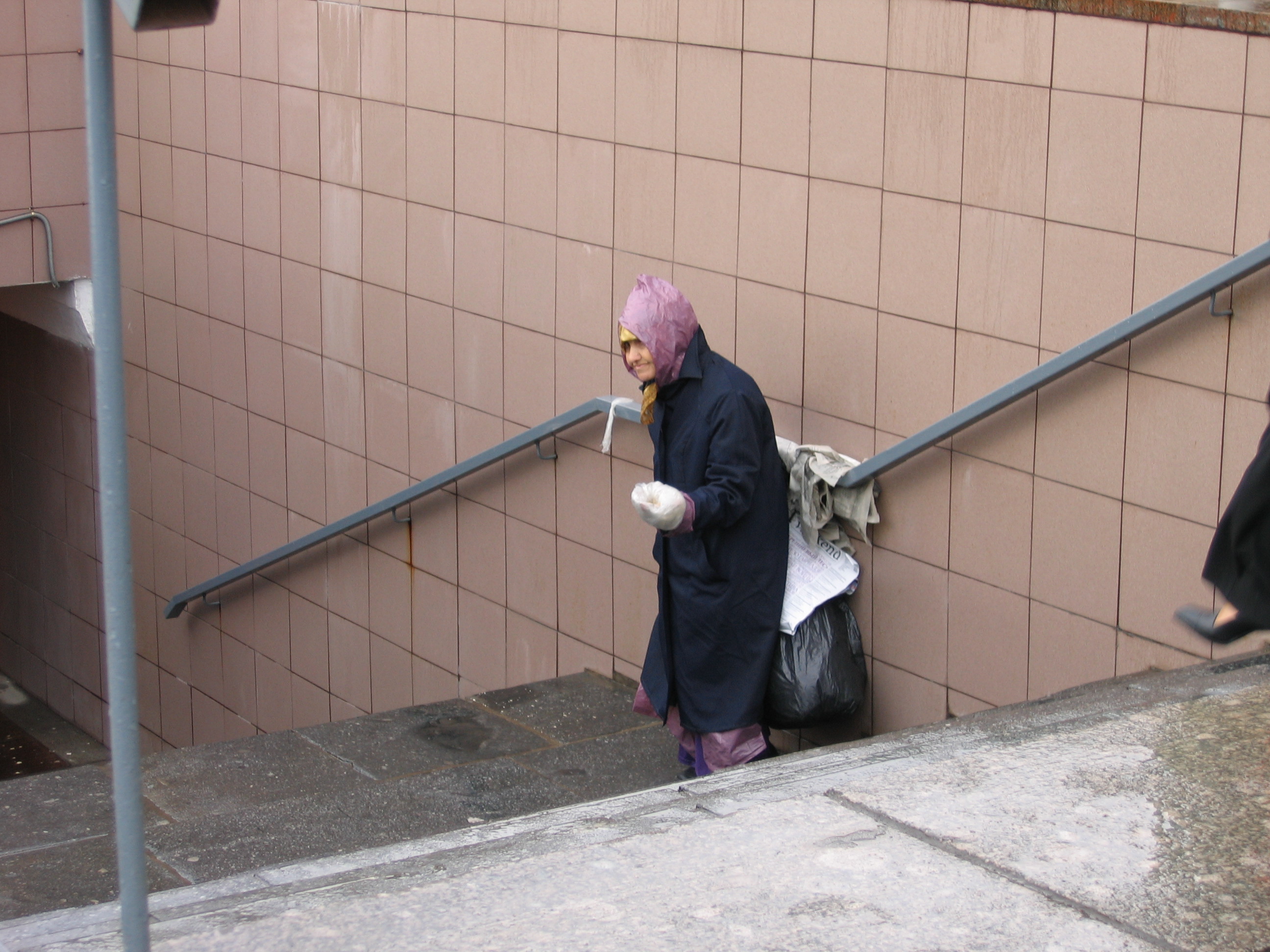
Economic inequality grows in Russia: On the left, the new GUM department store with lots of luxury goods. On the right, a woman begs for spare change in a Moscow subway.
"Tax Evasion,
Trust, and the Strong Arm of the Law," keynote speech to the
Conference on "Tax Evasion, Trust, and State Capacities," St. Gallen
University, St. Gallen, Switzerland, October 17-19, 2003. The
paper shows that tax compliance depends more on trust in government
than trust in people, using survey data from Romania and across
nations as well as aggregate data on tax compliance. Download
the paper in
PDF
format.
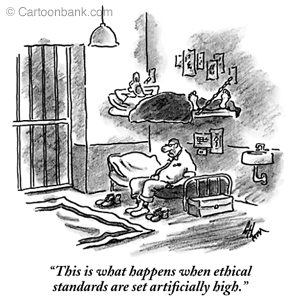
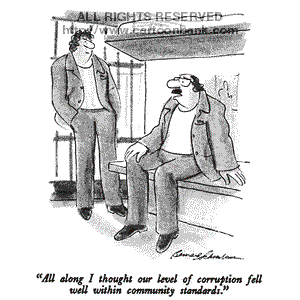
"Trust and Corruption," a paper examining the roots of corruption across societies--especially the linkage between democratization, trust, and corruption. Originally presented at the Conference on Political Scandals: Past, Present, and Future, University of Salford, United Kingdom, June, 2001 and at 2002 Annual Meetings of the American Political Science Association. This version will be published in Johann Graf Lambsdorf, Markus Taube, and Matthias Schramm, eds., Corruption and the New Institutional Economics (London: Routledge, 2004) (pdf version, WordPerfect version).
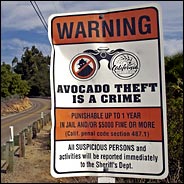 How
petty corruption can undermine
How
petty corruption can undermine
social capital in California.
"The Civil State: Trust, Polarization, and the Quality of State Government," forthcoming in Jeffrey Cohen, ed., Public Opinion in State Politics (Stanford University Press): States with higher levels of trust and lower levels of partisan polarization, both among citizens and elites, have better functioning governments (from measures from Governing magazine) and less corruption. Download the PDF version.
SEND E-MAIL TO ME AT: